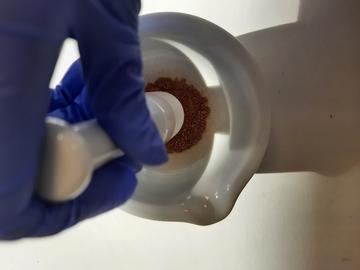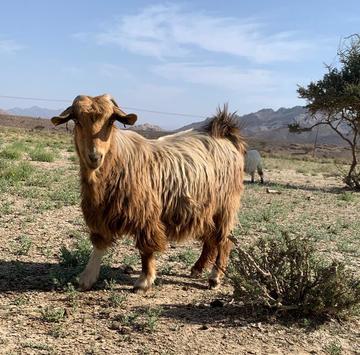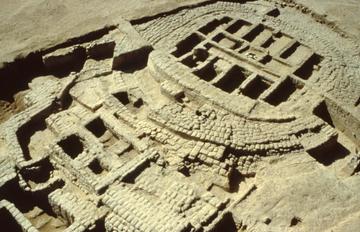Meat, dairy, and plant residues discovered in Early Bronze Age pottery vessels illuminate hidden histories of subsistence and long-distance exchange in south-eastern Arabia

Pottery fragment being crushed in preparation for analysis in the lab.
Credit: Akshyeta Suryanarayan
New research led by Dr Akshyeta Suryanarayan, a Wainwright Fellow based in the Faculty of Asian and Middle Eastern Studies, Oxford, has revealed surprising new details about everyday life and long-distance exchange in the ancient Arabian Peninsula. This research represents an international collaboration with researchers from institutions in Oman and Europe working on Arabian archaeology. Dr Suryanarayan is hosted at the McDonald Institute for Archaeological Research at the University of Cambridge.
Published in PLOS One, the study used organic residue analysis to examine Bronze Age pottery from archaeological sites in what is now northern Oman and the United Arab Emirates. Dating back to around 2800–2000 BCE, these vessels—some locally made, others imported from Mesopotamia and the Indus Civilisation—were found to contain traces of meat, dairy, and plant products.
The presence of pastoral products such as meat and dairy highlights the importance of herding, while the detection of plant residues—despite their low likelihood of preservation—suggest a diversity of commodities were used in pottery vessels and part of daily life.

Goats grazing in Oman.
Credit: Rita Kremer-Langen
Dr Suryanarayan says, “The results suggest the continued importance of pastoralism in Early Bronze Age Arabia even as date palm agriculture was adopted in the region. The evidence suggests dairying was practiced in southeastern Arabia by the third millennium BC, if not earlier.”
The research also reveals insights into the complex exchange networks that linked Arabia with the wider ancient world more than four millennia ago. Imported vessels from Mesopotamia and the Indus Civilisation found at these sites were used in practical ways, containing meat, dairy, plant and marine products.

Image of the archaeological site of Hili 8.
Credit: S. Cleuziou/French Archaeological Mission
Dr Suryanarayan adds, “These molecular traces may show how organic goods moved through exchange networks in the Gulf, or represent the re-use of the vessels. The direct detection of organic products in vessels give us insights beyond what we know from selective Mesopotamian texts from that time period.”
By combining cutting-edge biomolecular techniques with archaeological analysis, this research exemplifies the Faculty’s commitment to supporting innovative, interdisciplinary approaches to the study of Asia and the Middle East—past and present.
Link to article: https://journals.plos.org/plosone/article?id=10.1371/journal.pone.0324661
Contact: Dr Akshyeta Suryanarayan – corresponding author Gerald Averay Wainwright Fellow Faculty of Asian and Middle Eastern Studies University of Oxford as2429@cam.ac.uk